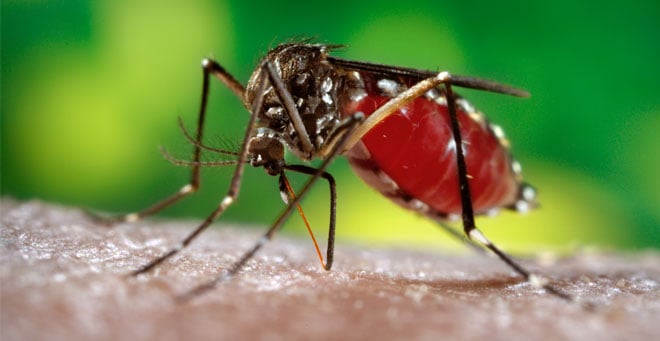 |
|
|
The Aedes agegypti mosquito, which spreads the Zika virus, is not widely found throughout New England, but it is not clear if the mosquito range will expand or if the virus will infect other insect species in the future. (Photo by James Gathany, courtesy of the Centers for Disease Control) |
Scientists at UMass Medical School studying congenital cytomegalovirus (CMV), an infection that can cause the same birth defect as the Zika virus, are looking to their past discoveries to accelerate research into both infections.
“The clinical syndrome associated with Zika and CMV is very similar,” said Laura Gibson, MD, associate professor of medicine and pediatrics, who sees infants with congenital CMV infection in Central Massachusetts. “What that means is that both viruses can pass from the mother to the fetus and attack the fetus’ brain, causing the destruction of brain tissue and leading to birth defects, such as microcephaly. The risk of severe effects on the brain is particulary high in early pregnancy when the brain is developing.”
In February, the World Health Organization declared a public health emergency of international concern after a Zika outbreak in Brazil appeared to be causing microcephaly and other birth defects. Last month, the Centers for Disease Control and Prevention confirmed that Zika can cause microcephaly and other birth defects. Internationally, global health leaders have been strategizing on how to minimize the spread and the impact of the Zika. The latest figures show that the number of cases of babies born with microcephaly in Brazil continues to rise. While it’s still unclear the impact Zika may have in the United States, there have been 426 Zika cases on the mainland in association with people who have traveled to endemic areas.
But still, most cases of microcephaly in the United States are associated with congenital CMV, according to the CDC. An estimated 30,000 infants every year in the United States are diagnosed with congenital CMV, and nearly 20 percent of them suffer permanent neurological disabilities.
Timothy Kowalik, PhD, associate professor of microbiology & physiological systems, and Dr. Gibson have been working closely on congenital CMV research. The Centers for Disease Control and Prevention recently concluded that there is sufficient evidence Zika is a cause of microcephaly.
“It’s a relief that the evidence confirms the link between Zika and microcephaly, because now efforts toward prevention and treatment will accelerate,” Gibson said. “Like with CMV, we want to understand what the Zika virus is doing to the brain, and how the fetal and maternal immune systems fight these viruses, to identify factors that increase or reduce risk to the fetus. This information will help design interventions to protect the mom and the baby.”
“There are a number of genetic changes that happen as the CMV virus infects and spreads throughout a fetus, and if we identify the relevant genetic changes, it may be possible to prevent fetal transmission and block the spread of CMV,” Dr. Kowalik said.
A virologist by training, Kowalik has spent years conducting research into how CMV evolves in the fetus. A 2013 study published in PLoS Genetics and a followup 2015 publication in Proceeding of the National Academies of Sciencesidentified new insights into the cause of CMV-associated birth defects.
Nicholas Renzette, PhD, a researcher in the Kowalik laboratory, Gibson, Kowalik and colleagues identified samples from the bodily fluids of congenitally infected infants during the first year after birth. Using next generation DNA sequencing, they found CMV populations evolve rapidly in humans. This discovery could one day be used to limit the ability of CMV to adapt to new hosts and prevent it from causing birth defects. Similar approaches are in development to understand how Zika virus spreads to fetuses during pregnancy, which can lead to microcephaly.
A crucial difference between Zika and CMV is how the viruses infect humans. CMV is spread by human to human contact. Zika is spread mostly by the bite of an infected Aedes agegypti mosquito, but also through sexual intercourse, according to the CDC. As mosquito season approaches in the United States, health officials are monitoring for signs of the Aedes aegypti mosquito as they begin to understand more about how the virus is spread.
“New England isn’t an endemic area for this type of mosquito, but the CDC does include small southern areas of Connecticut and New York in its estimated range. As Zika cases spread, it’s not clear if the Aedes aegypti mosquito range will expand or if the virus will infect other insect species in the future,” Gibson said. “Like CMV, the Zika virus can be transmitted by other routes including sexual, so infection outside the mosquito range is expected to occur.”